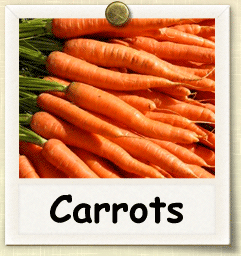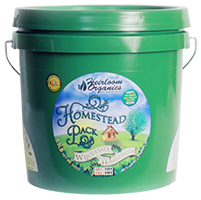|
Home > Guides > Vegetables > Carrot |
|
How to Grow Carrots | Guide to Growing Carrots |
|
|
|
|
| |
 |
|
Overview |
|
|
|
|
|
| |
|
| |
Careful attention to the soil makes these Vitamin A-rich roots a snap to grow. Plant in deep, stone-free soil (a raised bed is great) with a fine surface. Thin and weed carefully, and mulch to keep soil cool. |
|
| |
|
|
| |
Growing Guide
GROWING NOTES
Will tolerate very light shade.
Good quality roots require plentiful moisture and soil that is deep, loose, free of stones, and high in organic matter. Roots can become twisted and forked in heavy, stony soil. Prefers pH of 6.0 to 6.8 but can tolerate 5.5 to 7.5. Requires only moderate nitrogen. Too much can cause root branching.
Biennial grown as an annual.
Great crop for kids if planted in deep soil and site gets full sun.
MAINTAINING
Plant in spring, 2 to 3 weeks before last frost, ½ inch deep, ½ inch apart, in rows 12 to 24 inches apart. Deeply worked soil with fine, weed-free seedbed will greatly improve chances of successful crop.
Carrots are slow to germinate (1 to 3 weeks), and often germinate unevenly over a period of several weeks. To speed germination, water lightly daily if soil is dry.
Thinning is critical to reduce competition from neighboring plants. Thin to 1- to 4-inch spacings (depending on size of root desired) before plants are 2 inches tall. Cutting rather than pulling reduces disturbance of the remaining plants.
To improve germination in dry weather: Make a small furrow, about 2 inches deep. Plant seed and cover with about ½ inch of soil. Cover furrow with a board to retain soil moisture until seeds germinate.
Tip: Sow radishes in the same row. They germinate quickly, break the soil crust, and mark the row. Thin and/or harvest radishes before they compete with carrots.
Use seed tape or pelleted seed for more even spacings and less thinning. Or mix seed in roughly equal proportions with sand, fine vermiculite, or dried coffee grounds.
Mulch to keep soil cool, conserve moisture and to keep exposed "shoulders" from turning green and bitter. Another option is to hill soil over the shoulders.
Make additional plantings every three weeks through midsummer for continuous supply and fall harvest. Sowing in very early spring is possible, but some varieties will bolt if temperatures are too cold. Plant crops for fall harvest about 10 to 12 weeks before first frost.
Root quality is best when soil temperatures are 60 F to 70 F. The shape of the root is determined within the first few weeks after germination when the new plant extends its taproot deep into the soil. If it encounters obstacles (such as rocks or high water table) or is damaged, shape and quality of the root will suffer.
To prevent diseases, don't plant carrots in the same spot more than once every 3 years.
|
|
| |
|
| |
Heirloom seeds are the gardeners choice for seed-saving from year-to-year. Learning to save seeds is easy and fun with these books. Before you harvest, consider which varieties you might want to save seeds from so that your harvesting practice includes plants chosen for seed saving. Be sure to check out our newest seed packs, available now from Heirloom Organics. The Super Food Garden is the most nutrient dense garden you can build and everything you need is right here in one pack. The Genesis Garden s a very popular Bible Garden collection. The Three Sisters Garden was the first example of companion planting in Native American culture. See all of our brand-new seed pack offerings in our store.
|
|
| |
|
|
| |
Harvesting Guide
HARVESTING
Begin harvesting carrots when they turn bright orange (normally 60 to 80 days after planting, depending on the variety).
Because all sizes of carrots are edible they can be harvested over a long period of time. One of the main benefits of growing carrots is that they will remain fresh in the soil for many months, even after the tops have been killed by frost. If your garden soil is well drained you can keep carrots in the ground and covered with leaves or straw until the soil begins to freeze.
Picking a small amount of carrots for a family meal can be done with a small hand trowel being careful to stay far enough away from the plant as to avoid damaging the carrot itself. Harvesting carrots on a larger scale can be done by using a pitchfork or shovel and dig alongside the row. Be careful not to stab or cut the roots of the carrot. Pull the tops up and shake the soil off the roots. Storing carrots is easily done and if done properly they will stay fresh up to 3 to 4 months. Simply wash off all excess soil and place them in airtight containers or plastic bags.
SAVING SEEDS
To harvest your carrot seed, keep an eye on the umbels of flowers, and cut them off with pruning shears as they start to turn brown and dry. If you have plenty of plants, just save seed from the first and second umbels of flowers to appear on each plant, as these will give the biggest and best seed. Dry the seed heads further inside, and then rub them between your hands or in a sieve to separate them. You will notice that the seeds have a 'beard' which is removed in commercial seed to make them easier to pack.
You can sieve the seeds further to remove more of the chaff, but there is no need to get the seed completely clean - just sow slightly more thickly to allow for the chaff mixed in.
Dried carrot seed is relatively short lived, but if it is stored somewhere cool and dry, it should give good germination for 3 years. Seeds can be safely stored for at least three years. Place seeds in jars, manila envelopes, cloth or mesh bags, plastic containers, or foil envelopes. The best containers are air-tight, such as a sealed glass jar, metal can, or foil envelope. Protect seed from sunlight.Store seeds in a cool (below 15 °C is ideal), dry location. Place the seeds in a refrigerator for long term storage.
|
|
| |
|
|
|
| |
|
|
|
|
|
| You can find this variety in the following Seed Packs: |
|
  
  |
|
| Click the packs below to see some of our other wonderful products |
|
|
|
|
|
|
|